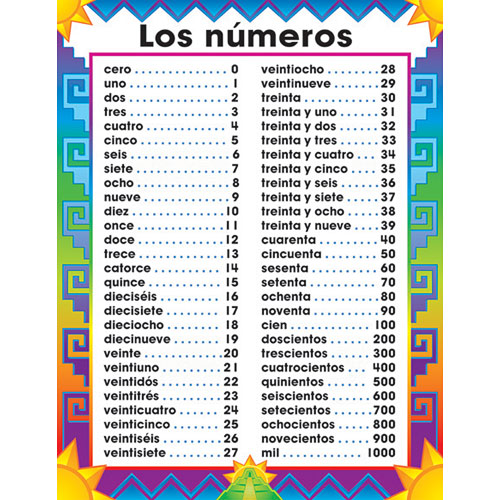

Learning the numbers will help you a lot in asking and understanding those questions:

#Say numbers in spanish how to#
Note that these words are adjectives (because they describe a noun), so you have to make them masculine, feminine or plural, depending on what you’re talking about.When I travel, I like to know at least some basic questions and how to respond to them. We don’t use ordinal numbers for the date in Spanish (like in English), but you do need them to talk about things like floor numbers, directions and who has won competitions (she won first prize, for example). Ordinal numbers are words that describe a sequence or order, like “first,” “second,” “third,” etc. For example: Seiscient os espejos, seiscient as mesas, etc. When a number ends in ientos,the adjective (the number) agrees with the noun (the thing we are counting).So it’s veintiún espejos (21 mirrors) because espejos is masculine. We also shorten other numbers that end in uno to ún (note the accent). When a noun is masculine, uno becomes un.It’s also used in expressions or refrains, usually coming from old Spanish. Use ciento when attaching smaller numbers in the 10s and 1s: ciento cuarenta, ciento sesenta, etc.It’s also used as an adjective when followed by the numbers mil, millón, billón (ie. Cien is used as an adjective before nouns, such as: cien naranjas, cien días.This is a pretty easy way to catch Spanish numbers used “in the wild” and learn other new terms in context. Each video also comes with interactive subtitles, which let you hover over new words and structures you don’t know. The best way to pick up on these number rules is to immerse yourself as much as possible and listen to how natives pronounce things.įor example, you could use FluentU to watch authentic Spanish videos featuring native speakers in a variety of different contexts. If you need to be precise, it might be worth asking ❼uánto es un billón? (How much is a billion?). But in practice, how many millions there are in a billion varies wherever you are. system, where a billion is a thousand million. Officially, the whole world has now decided to go with the U.S. So 100,000 in English becomes 100.000 ( cien mil).Ĭongratulations, you can now use these rules to count up to a million!Ī million in Spanish is un mill ón or 1.000.000.Ħ.986.410 - Seis millones, novecientos ochenta y seis mil, cuatrocientos diezĪnd a un billón (a billion)? Well, that depends on which system you’re using, as there’s some debate about how many a billion actually is. Note that after mil, in Spanish, we use a period to separate our numbers instead of a comma, like we use in English. For example:Ĥ6,155 - C uarenta y seis mil, ciento cincuenta y cinco system - Un millardoīeyond one thousand, you use the appropriate number to signify how many thousands you have. Another word for a billion in the U.S.1 Thousand million (a billion in the U.S.

1 Billion (a million millions) - Un billón.So, following this pattern, 104 is ciento cuatro. 147 is ciento cuarenta y siete not ciento y cuarenta y siete. There’s also no y used with these larger numbers because the y is only used to separate the 10s from the 1s (42 = cuarenta y dos) but not the 100s from the 10s (142 = ciento cuarenta y dos). Note that c ien is only used to say 100 even- anything above that and we’ll use ciento. For example:įor more practice with Spanish numbers 1 to 100, I recommend watching this comprehensive video from Butterfly Spanish on YouTube: Note that to make specific numbers past 30, you have to use y (and) to connect the 10s with the 1s. This idea of combining numbers will be a common theme throughout this post. Notice that dieciséis (16) is made up of diez (10) and seis (6), which together make 16.
#Say numbers in spanish pdf#
This blog post is available as a convenient and portable PDF that you In this post, you’ll learn everything you need to know about Spanish numbers, including how to count from one to a billion, grammar rules for numbers, ordinal numbers and more. Knowing how to count in Spanish is a vital skill-almost everything involves numbers in some way, from asking for the time, to giving your age, to watching a Spanish documentary about a historic event. Master Spanish Numbers From 1 to 100 and Beyond!Īddresses, time, dates, cooking, measurements.


 0 kommentar(er)
0 kommentar(er)
